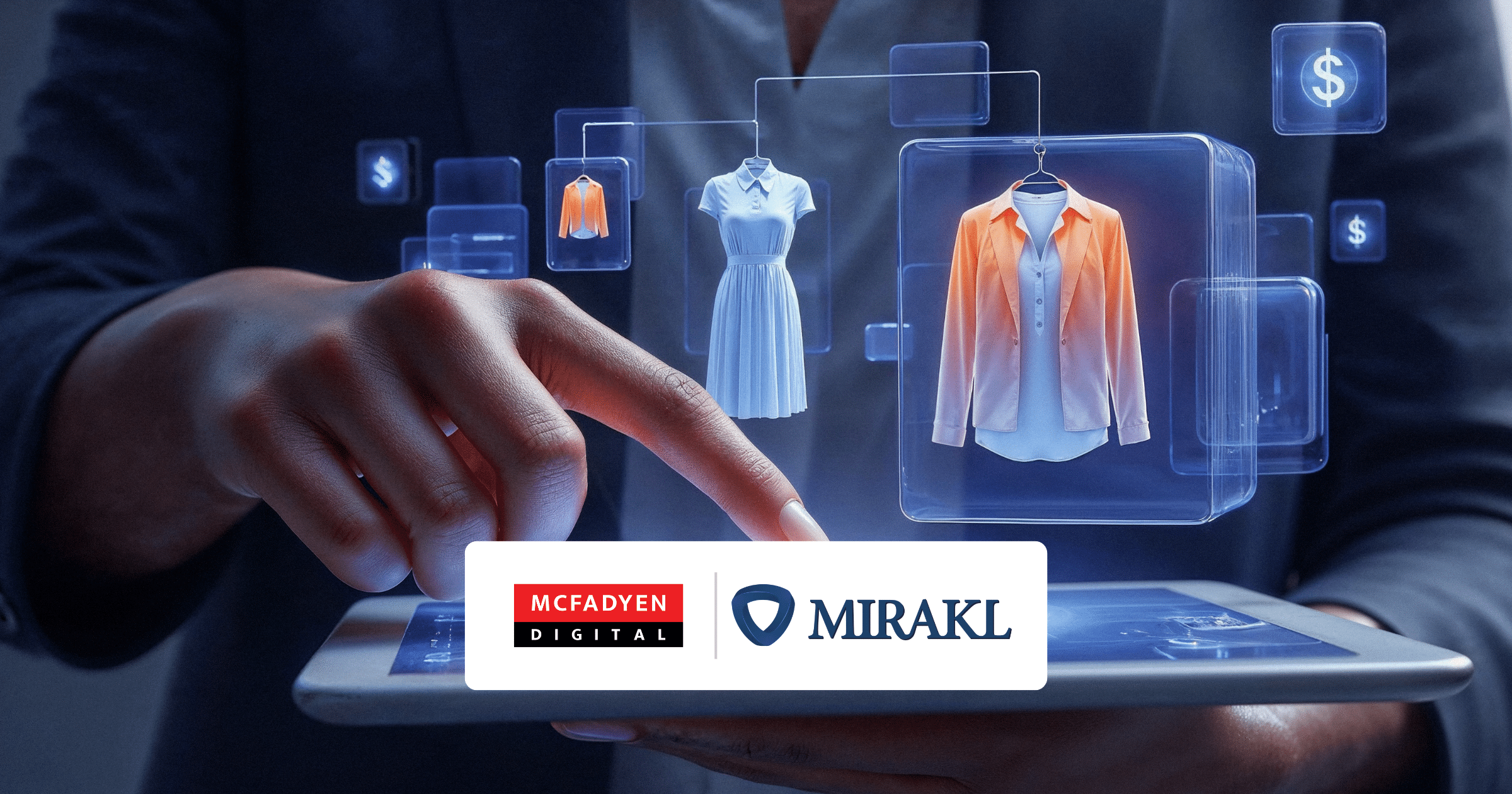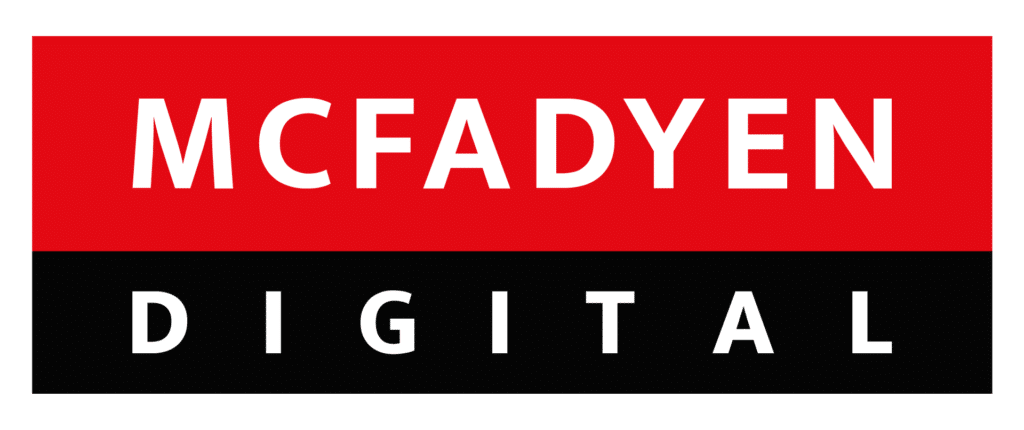
Featuring Jeffrey Mikos (McFadyen Digital) and Dickel Sooriah (Mirakl) · Moderator: Debora Omena (McFadyen Digital)
About the speakers:
Jeffrey Mikos — McFadyen Digital. Jeff leads McFadyen Digital’s Strategy Practice, helping mid‑market enterprises turn complex B2B commerce challenges into growth. He guides organizations through platform selection and implementation, customer experience optimization, and business‑process transformation to unlock new revenue while simplifying operations.
Dickel Sooriah — Mirakl . A product and industry solutions leader with 25 years in enterprise software, Dickel sets the strategy for manufacturers, wholesalers, and procurement organizations to evolve from traditional models to marketplace, omnichannel, and now agentic commerce. He shapes roadmaps across e‑invoicing and tax, payment orchestration and supplier payouts, order orchestration (ERP/WMS/OMS), and procurement connectivity, with deep expertise in building & construction, heavy industrials, automotive, aerospace, and materials & components.
Intro
B2B purchasing is in the middle of a once‑in‑ageneration shift. Buyers now expect consumer grade convenience with enterprise grade control, while operators are racing to unify firstpart, dropship, and marketplace models. In this candid conversation, McFadyen Digital and Mirakl — longtime partners helping brands and distributors launch and scale marketplaces—explore what’s changed, what still works, and how to build a unified commerce layer that’s ready for agentic experiences.
‑Below is the verbatim Q&A (lightly formatted) from our recorded discussion.
Q1) How have B2B buyers fundamentally changed, and what are they demanding now that’s completely different from three years ago?
Jeffrey Mikos (McFadyen)
I can go first. Complexity has always existed, and in a B2B context it’s even more pronounced than in B2C. What has shifted is buyers’ expectations for transparency into that complexity. More than ever, buyers are willing to procure tens or even hundreds of thousands of dollars digitally. Three, five, ten years ago, those transactions were largely offline for most organizations. Now buyers are willing to spend that kind of money via digital transactions, but they still expect human interaction for complex purchases. They want digital to play a role alongside humans: collaborating in a shared online project folder as they build configurations, having a live video consultation with a subject-matter expert, or getting answers about installation or implementation. The expectation for how they interact with humans—enabled by digital—has changed from three years ago.
Dickel Sooriah (Mirakl)
I agree on human interactions. If I break down the question, the part that hasn’t changed is the number of interactions in B2B transactions. The “rule of three” still holds: one-third happen in person, one-third remotely (phone or assisted), and one-third are self-serve. What has changed is how we help these interactions work together. Customer experience solutions now allow us to unify them. It started with ecommerce—platforms gave buyers access to more products, which we’ve been a key part of. Now they’re asking to bring agentic conversations into the mix to make things easier. What’s changed is how we bring these interactions together reliably.
Dickel: “The “rule of three” still holds: one-third happen in person, one-third remotely (phone or assisted), and one-third are self-serve.”
Q2) How are consumer experiences from Amazon or Netflix raising the bar for B2B purchasing? What tools and features have become non-negotiable expectations?
Dickel Sooriah (Mirakl)
There are very specific B2B needs. For example, in building and construction, buyers want to specify delivery windows and constraints. They may need delivery during business hours or to construction sites with special access needs. We’re beyond just saying they’re Amazon and Netflix users. Yes, they expect mobile access, easy browsing, and rich catalogs. We’ve improved product content quality with enriched media—images and increasingly videos—because manufacturers are providing content to train B2B buyers. These expectations were driven by consumer experiences, but now they also want recognition of their unique needs.
Jeffrey Mikos (McFadyen)
This is a popular topic because Amazon usage is ubiquitous. Amazon is one of the most customer-centric organizations in the world, constantly iterating for a broad consumer grade experience. But we have to consider a specific industry and customer personas. What problems are they solving with digital? You can’t just check a box and say, “We created an Amazon-like experience,” and expect to win in B2B. While B2B buyers use Amazon, Netflix, or Instacart personally, at work they’re trying to complete tasks. They don’t want billboards of products from unknown suppliers. That might be fine for the long tail, but Amazon shouldn’t be your North Star in B2B.
I do see a future where cutting-edge technology from Amazon becomes relevant in B2B—AI models recommending products based on purchase history, or chat commerce like Rufus. There won’t be a one-to-one replica for everyone, but these experiences will matter in B2B. We coach clients to think about whether to innovate or renovate. Do you rebuild the whole house, or redo the kitchen? Generally, renovate three areas first: core commerce, payments and authorization, and fulfillment and returns. Modernize platforms and APIs in those domains to set the foundation for the right Amazon/Instacart/Netflix-like experiences relevant to your customers.
Jeff: “Generally, renovate three areas first: core commerce, payments and authorization, and fulfillment and returns.”
Dickel Sooriah (Mirakl)
I love what you said about fulfillment and payments. A significant part of B2B complexity is payments and invoicing—the big separator between B2C and B2B. There’s a wide variety of B2B payment options, and we must integrate with credit management. Beyond delivery options, there’s another change. At an event yesterday, I got the same question but framed around ChatGPT. Many wholesalers said their buyers won’t use public assistants because their portals are gated, with personalized pricing and account constraints. But they are working on agentic experiences—assistants that help during ordering within authenticated environments.
We’re building the Mirakl Nexus platform for agentic commerce that understands ordering constraints, pricing, order history, recommendations, split orders, and post‑sales status—conversationally. They want B2C-style assistance, adapted for B2B. This is hyper-personalization, but in B2B it means job-site delivery constraints, approval workflows, split shipments, non-standard locations, and more. That’s the real B2B version of personalization. The future is bright, interesting, and difficult.
Where B2B teams get stuck?
Q3) “Digitalfirst ” and omnichannel sound great, but where do B2B organizations really get stuck?
Jeffrey Mikos (McFadyen)
We could spend an hour on this—from planning and budgeting to ownership and executive support. everyone hears they have to be digital-first and omnichannel, with a huge martech stack. But the challenges are huge for B2B organizations that have worked a certain way for years. Our bread and butter is implementing technology, and we’ve been doing it for 40 years. We can count on one hand the times when technology itself was the root cause of failure. More often, it’s the human element—organizational culture and internal adoption.
Three common pitfalls:
- Big Bang: full rip-and-replace across domains (ERP, commerce, Mirakl for multi‑vendor, PIM, OMS, etc.). It’s overwhelming to do too much at once.
- Digital theater: the site looks beautiful publicly, but behind the scenes the complexity remains. That won’t solve real problems.
- Treating digital as a project rather than a business strategy: doing the tech part well but ignoring internal adoption and mindset shifts.
Dickel Sooriah (Mirakl)
Our customer success teams seek the highest level of executive sponsorship; otherwise, nothing happens. Mirakl projects often drive business model transformation, not just digitization, so without top-down sponsorship, roadblocks appear daily.
Where companies get stuck can be summarized in one word: fragmentation. Inventory is spread everywhere—acquisitions with separate ERPs and warehouses, distributors with their own systems, and no way to expose or syndicate unified catalogs. Manufacturers have inventory across distributor locations but no means to bring it together. Distributors are often too small to invest in robust digital platforms with enriched data. Projects stall because no one is solving fragmentation. Increasingly in B2B, wholesalers and manufacturers ask us to provide a unified commerce layer to address it.
Dickel: “Where companies get stuck can be summarized in one word: fragmentation.”
Jeffrey Mikos (McFadyen)
It’s easy to forget that Mirakl’s involvement almost always implies a business model transformation. You’re net-new most of the time, introducing change and disruption to old models. Our job is often to reconcile multiple business models on one digital platform: extending into new categories via a low-risk, asset-light marketplace model, rethinking and digitizing dropship programs, and unifying first-party business across acquired companies. The question becomes: how do you build a unified layer across all of these and make sense of the different business models you want to run?
Multi-Partner Complexity
Q4) Why the rise in multi‑partner complexity—more suppliers, partners, and channels—and why is it hard to manage?
Jeffrey Mikos (McFadyen)
First, there’s simply more to manage. Digital allows multiple partners and channels. Fifteen years ago, we wouldn’t be having this conversation; back then it was “how do we build this?” Now you can go from concept to production in months. Mirakl is incredibly flexible, powerful, and modular. Still, the multi-vendor marketplace model isn’t for everyone.
Drivers of the model:
- Buyers want to consolidate their supplier ecosystem. It’s easier to manage 10–15 suppliers than hundreds. Operators help buyers consolidate by expanding product portfolios and offerings.
- Speed to market. Mirakl accelerates bringing products to market without buying inventory, slotting in warehouses, or self-distributing. Within weeks, you can get proof points in production.
- Supply-chain resilience. COVID exposed the risk of single-source supply. The multi-vendor model diversifies supply quickly.
But it takes work. You rely on third-party suppliers to represent your brand. You must protect your IP and customer experience. The best operators mitigate risk with explicit seller recruitment and onboarding strategies. Early on, they gate participation and ensure suppliers align with their culture and value proposition.
Dickel Sooriah (Mirakl)
A client shared this at our summit. They wanted to develop new categories and saw the marketplace model as a quick way to onboard suppliers. Internally, procurement resisted opening new categories or adding options to existing ones, fearing competition with current lines. With data, we showed that introducing new options in existing categories drives significant value.
Then larger manufacturers said, “We can also route products through your Mirakl‑powered model in those new categories.” The wholesaler ends up with one platform running two to three business models: testing new categories with low risk, letting the operator sell directly under the marketplace model, and, based on performance, moving products into frame agreements. They can switch categories between models depending on performance.
Regarding multi-partner complexity, we’ve onboarded both niche small suppliers and large established suppliers from wholesale dropship programs. We must ensure our supplier portal works efficiently for both—a billion-dollar supplier and a small niche vendor—with very different integration expectations. The goal is a unified platform that covers a broad spectrum while giving each vendor what they need to push their products
Q5) What is the step-by-step process to transform business operations?
Dickel Sooriah (Mirakl)
Mirakl has a standard methodology. First, by industry, be precise about who you want to sell to—customer segments and growth strategy. Many clients don’t aim to acquire new customers; they want to sell more to existing ones. Others target new segments. We ensure clarity on target customers.
Then move to the supplier side: which categories to open, who to onboard, and what’s available within your chosen business model to reach your desired outcomes. Our platform advisory team provides a methodology to show expected business outcomes and helps present them to the board.
Next, avoid putting too much into the initial vision. Embrace MVP. We bring pioneers to share experience and keep an MVP mindset to prove value quickly and unlock further strategies by building on success. Third, focus on curation and assortment strategies, and supplier onboarding. Plan the first three months and the six months after. It’s tied to the MVP but becomes an engine for acceleration.
Jeffrey Mikos (McFadyen)
Anchor on business outcomes. What are your goals? Who do you serve? Do you want to grow share of wallet, enter new geographies, or launch new categories? Platforms are tools to achieve those objectives. A popular offering is “fit-for-purpose platform selection”—de-risking transformation for boards and execs.
There are three approaches:
- Build it yourself (rarely viable).
- Best-of-breed/composable stack (common in complex scenarios).
- All-in-one suites (fit for more straightforward models).
Most of our clients fit best-of-breed, stitching together platforms for elegant, successful experiences. Our recommendations align with your complexity and throughput, and with your organization’s skills, culture, and philosophy. On MVP: companies can’t wait 12–24 months for results. They need outcomes in 4–6 months. MVP isn’t just shipping something minimal—it’s a way to get feedback and iterate. Evolution, not revolution.
Q6) One piece of advice for B2B leaders to stay competitive: what separates those who’ll thrive from those who’ll struggle?
Dickel Sooriah (Mirakl)
One consistent driver of competitiveness is understanding unmet demand. Many clients with digital channels see searches and orders on their platforms, but they don’t capture what’s missing. Field sales talk to customers, but not systematically about unmet needs. We work with clients to analyze zero-result searches to identify expectations and missing categories. If we can quantify the missed demand, it guides category expansion.
Our customer success teams also interview buyers to learn “what else do you need,” not just what is ordered today. Companies that fail are often too comfortable focusing only on current orders without watching how rapidly the landscape evolves. We see this across industries: automotive (remanufactured parts), food service (ethnic categories, allergen information), building and construction, agriculture, chemicals—constant requests for new categories and attributes.
Jeffrey Mikos (McFadyen)
Things are moving fast. I’d advise leaders to align and structure their organization—people, groups, metrics, KPIs—for fluidity. Be prepared to react and take advantage of change. Many organizations are rigid, with departments tied to product divisions, geographies, or channels. That makes it harder to see a customer as one entity across divisions.
Create a uniform customer interaction map and get closer to your customer. A parallel from outside B2B: Palantir, long associated with defense, is valued not just for current revenue but for potential in commercial markets—connecting disparate customer data inputs and signals. Whether or not they pursue that, the idea is right: the next frontier is stitching together customer data to unlock a true unified view. Agentic commerce is coming in some capacity, but the back office—achieving a customer view you’ve never had before—and designing your organization to exploit it is what I’d recommend to any executive.
Keep learning. Check out more in-depth insights on the topics of this conversation:
Today’s B2B Buying Maze: Why Complexity Is Your Biggest Risk: B2B buying has become a high-stakes maze: more channels, more people, and more information to reconcile. Buyers jump across websites, chat, video calls, and in-person touchpoints, often without ever talking to a rep. Meanwhile, internal committees must build consensus as they sift through piles of content. This post expands on the infographic to explain what’s changed, why it matters, and how to turn the chaos into competitive advantage. [keep reading]
The New Rules of B2B Commerce: Why Distributors Can’t Afford to Delay Digital Modernization:
Wholesale distributors face unprecedented pressure to modernize. Professional buyers expect seamless, self‑service digital experiences, while marketplace leaders raise the competitive bar. Standing still risks customer attrition and margin erosion, whereas modernization delivers growth, efficiency, and agility. This post outlines the new rules of B2B commerce, the risk of delay, and a pragmatic path to modernization—supported by McFadyen Digital case examples and frameworks—so leaders can reduce risk while accelerating impact. [keep reading]
Related Articles
Turn Insight Into Impact.
Start Today.



